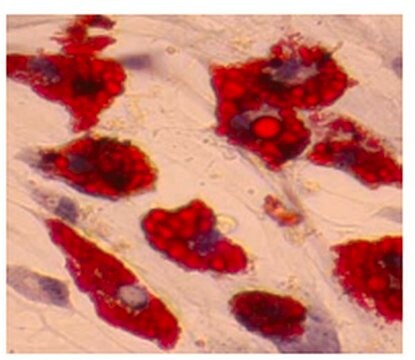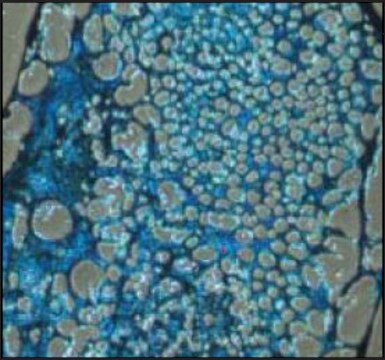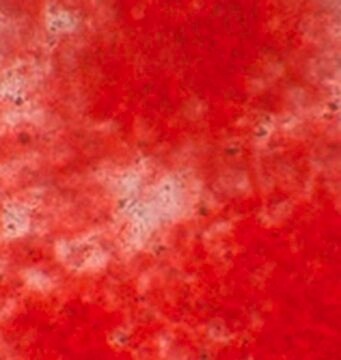Recommended Products
manufacturer/tradename
Chemicon®
Quality Level
technique(s)
cell based assay: suitable
detection method
colorimetric
General description
The biochemical pathways of adipogenesis have become increasingly well understood with the use of the 3T3-L1 model (reviewed in Gregoire et al., 1998; Rosen et al., 2000). Treatment of cells with dexamethasone activates the transcription factor CCAAT/enhancer-binding protein b (C/EBPb). IBMX inhibits soluble cyclic nucleotide phosphodiesterases and results in increased intracellular cAMP levels (Elks and Manganiello, 1985). At the nuclear level, treatment with IBMX results in activation of the related transcription factor C/EBPd. C/EBPb and d in turn induce transcription of C/EBPa and PPARγ. Within 3 days of exposure to inducers, the cells undergo two rounds of mitosis, termed mitotic clonal expansion, which are required for differentiation (Tang et al., 2003). Insulin or insulin-like growth factor-1 promote adipocyte differentiation by activating PI3-kinase and Akt activity. Modulation of the activity of the forkhead transcription factor Foxo1 appears to be necessary for insulin to promote adipocyte differentiation (Nakae et al., 2003). C/EBPa and PPARγ direct the final phase of adipogenesis by activating expression of adipocyte-specific genes, such as fatty acid synthetase, fatty acid binding protein, leptin and adiponectin.
Endogenous negative regulators of adipocyte differentiation, such as Pref-1 and Wnt-10b, are highly expressed on undifferentiated 3T3-L1 cells, and are down-regulated upon addition of adipogenesis inducers (Ross et al., 2000; Mei et al., 2002). In addition, cytokines such as tumor necrosis factor alpha (TNFa) and transforming growth factor beta (TGF-b) interfere with adipocyte differentiation (Gregoire et al., 1998).
The identification of regulators of adipogenesis raises the prospect of preventing or reversing obesity through pharmacological means. PPARγ has received particular attention as a target, as it is essential for the final phase of adipocyte differentiation and is a pharmacological target for the thiazolidinedione class of antidiabetic drugs. The pro-adipogenic effect of the thiazolidinediones has led to interest in identifying compounds that retain antidiabetic activity without promoting adipogenesis. In addition, inhibitors of PPARγ activity have been identified that inhibit adipogenesis, and might serve as the basis for development of effective anti-obesity drugs (Wright et al., 2000; Camp et al., 2001).
Application
Cell Structure
Components
Insulin Solution - (Catalog No. 90356) - One vial containing 250 μl of 10 mg/mL recombinant human insulin.
Dexamethasone Solution - (Catalog No. 90357) - One vial containing 100 μl of 10 mM dexamethasone in ethanol.
Oil Red O Solution - (Catalog No. 90358) - One bottle containing 60 mL 0.36% Oil Red O solution in 60% isopropanol.
Wash Solution - (Catalog No. 90360) - Two bottles containing 250 mL each of wash solution.
Dye Extraction Solution - (Catalog No. 90359) - One bottle containing 30 mL of dye extraction solution.
Storage and Stability
Dexamethasone Solution, IBMX Solution and Insulin Solution should be stored at -20ºC. Oil Red O Solution, Wash Solution, and Dye Extraction Solution should be stored at room t
Legal Information
Disclaimer
Signal Word
Danger
Hazard Statements
Precautionary Statements
Hazard Classifications
Aquatic Acute 1 - Aquatic Chronic 2 - Eye Dam. 1 - Flam. Liq. 2 - Repr. 1B - STOT SE 2 - STOT SE 3
Target Organs
Central nervous system, Eyes,Central nervous system
Storage Class Code
3 - Flammable liquids
Flash Point(F)
48.2 °F
Flash Point(C)
9 °C
Regulatory Listings
Regulatory Listings are mainly provided for chemical products. Only limited information can be provided here for non-chemical products. No entry means none of the components are listed. It is the user’s obligation to ensure the safe and legal use of the product.
JAN Code
ECM950:
Certificates of Analysis (COA)
Search for Certificates of Analysis (COA) by entering the products Lot/Batch Number. Lot and Batch Numbers can be found on a product’s label following the words ‘Lot’ or ‘Batch’.
Already Own This Product?
Find documentation for the products that you have recently purchased in the Document Library.
Our team of scientists has experience in all areas of research including Life Science, Material Science, Chemical Synthesis, Chromatography, Analytical and many others.
Contact Technical Service












